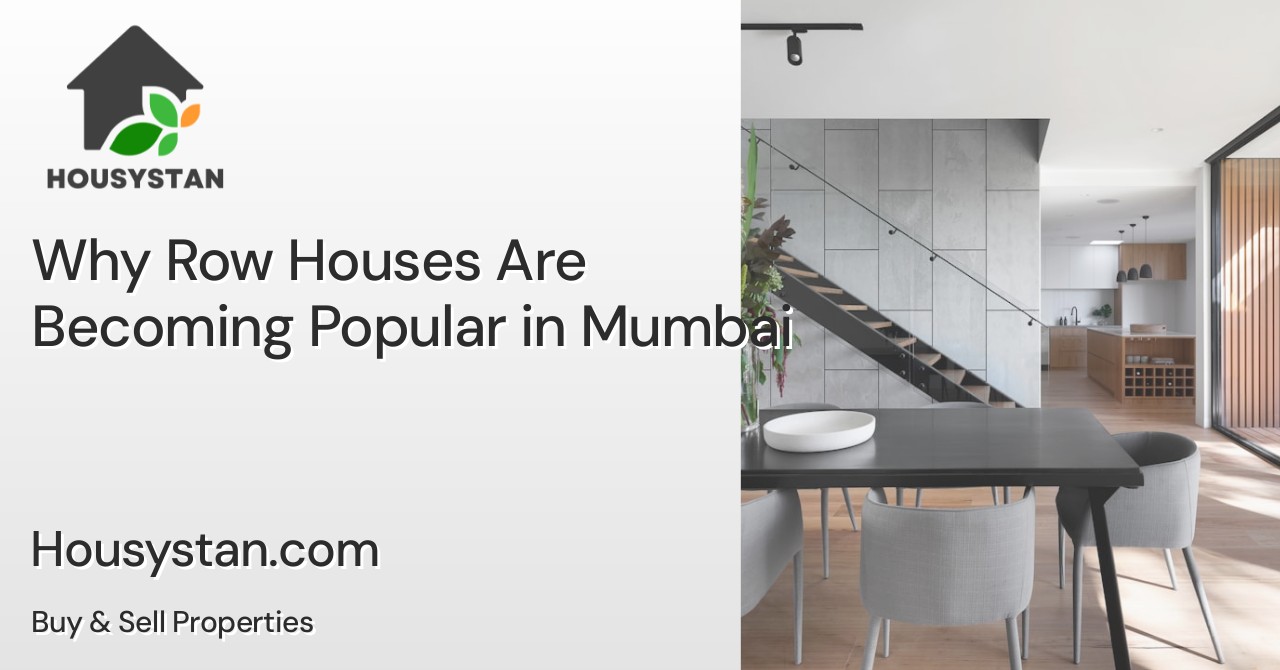Why Row Houses Are Becoming Popular in Mumbai
Read latest blogs and articles from Housystan

The Information mentioned here was last updated on:
21/12/2025Why Row Houses Are Becoming Popular in Mumbai
The Rise of Row Houses
In recent years, Mumbai has witnessed a noticeable trend in real estate—an increasing number of people are gravitating toward row houses. This might seem surprising given the city's traditional preference for skyscrapers and high-rise apartments. However, there are multiple reasons behind this shift.
- Verified Tenants/Buyers
- Unlimited Property Listing
- Zero subscription/charges fee
Space and Privacy: A Winning Combination
One of the primary attractions of row houses is the promise of more space and privacy compared to apartment living. In a bustling city like Mumbai, where every square foot is precious, the allure of a row house lies in the offering of multiple levels and often a small garden or patio. Unlike apartments, where walls are shared with multiple neighbors, a row house typically shares walls with just one or two neighboring houses, providing an enhanced sense of privacy.
A Sense of Community
Despite the private space that row houses offer, they also foster a community spirit. Row houses are often built in clusters with shared amenities like parks, playgrounds, and sometimes even clubhouses. This setup allows for a tighter-knit community where people can socially interact and be a part of community activities. For many families, particularly those with young children, this blend of privacy and community is highly appealing.
A Nod to Nostalgia
For some, the pull toward row houses is rooted in nostalgia. Many parts of Mumbai were once characterized by traditional row houses, akin to those found in Bandra or Girgaum. As Mumbai modernized, many of these structures were replaced by towering apartments. However, developers have noticed that there's a segment of the population that yearns for the charm and character of row house living, spurring a resurgence in their construction.
Modern Amenities With a Traditional Feel
Today's row houses aren’t just about old-world charm—they seamlessly blend modern amenities. Mumbai's new row houses are often equipped with state-of-the-art facilities such as modular kitchens, high-speed internet connections, and smart home technologies. This combination of chic, modern interiors within a traditional framework is appealing to a wide range of buyers, from young professionals to retirees looking for comfort and convenience.
Investing in Row Houses: A Lucrative Choice?
From an investment perspective, row houses are becoming increasingly popular in Mumbai. The city's relentless population growth means that there's always demand for housing, making real estate a sound investment. Row houses, with their unique blend of community living and privacy, cater to a market that values lifestyle as much as location. Additionally, as urban areas become more saturated, suburban locations where row houses are typically found tend to promise a higher appreciation value over time.
Sustainability and Green Living
Another factor driving the popularity of row houses is the growing awareness and concern for sustainable living. Many row house developments in Mumbai are part of gated communities that emphasize green living. With more space to incorporate green solutions, homeowners find it easier to adopt eco-friendly practices, such as rainwater harvesting systems, solar panels, and organic gardens. As the environment becomes a more significant consideration in purchasing decisions, row houses offer a tangible way to live more sustainably.
Lower Maintenance Hassles
While high-rise apartments require maintenance fees that typically cover shared amenities and common areas, row house owners sometimes find these costs more manageable. This is because row houses often come with fewer common areas and amenities to maintain. With a smaller community, there may be a more streamlined and transparent process for handling maintenance and repairs, which can be a significant draw for potential buyers.
Flexibility and Customization
Row houses usually provide more flexibility when it comes to modifications and expansions. Unlike apartment complexes, where any renovation requires approval from a residents' association or building management, row houses often come with the ability to customize or expand more freely. This autonomy allows owners to design their space according to their needs and preferences, whether it’s adding an extra room, building a terrace garden, or changing the interior layout.
Accessibility to Key Locations
The strategic development of row houses in Mumbai also speaks to their rising popularity. Developers are building these homes in areas that offer easy access to the city’s primary business hubs, educational institutions, and entertainment zones. This ensures that residents do not have to compromise on connectivity and convenience in exchange for the quieter, more relaxed lifestyle that row houses offer.
Row Houses and Work-from-Home Trends
With the increasing prevalence of remote work, many professionals are seeking living spaces that can accommodate a home office. Row houses, with their additional space and separate rooms, provide this flexibility without encroaching on personal living areas. The pandemic has underscored the importance of having a versatile home, and row houses can effectively cater to this need.
The Role of Developers in Popularizing Row Houses
Real estate developers have played a significant role in the resurgence of row houses in Mumbai. By leveraging modern design trends, sustainability principles, and strategic location planning, developers have managed to make row houses a viable and attractive alternative to traditional apartment living. By marketing them as 'smart homes' or 'boutique residencies,' developers are appealing to a new breed of homeowners looking for something unique.
Row houses are increasingly becoming a preferred choice for Mumbaikars through a combination of nostalgia, privacy, community spirit, and modern amenities. With the urban landscape constantly evolving, row houses provide a refreshing blend of the past with the conveniences of contemporary living. As this trend continues to grow, it will be fascinating to see how row houses shape the future of Mumbai’s real estate market.